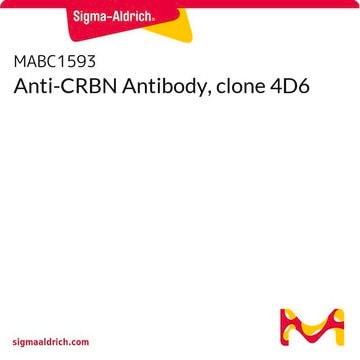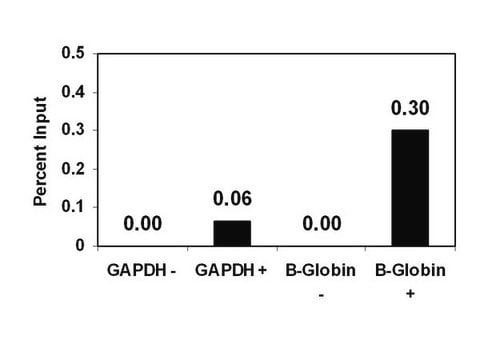17-648
ChIPAb+ Dimethyl-Histone H3 (Lys9) - ChIP Validated Antibody and Primer Set
serum, from rabbit
Synonyme(s) :
H3K9me2, Histone H3 (di methyl K9), Histone H3K9me2
About This Item
Produits recommandés
Source biologique
rabbit
Niveau de qualité
Forme d'anticorps
serum
Clone
polyclonal
Espèces réactives
human, mouse
Réactivité de l'espèce (prédite par homologie)
mammals
Fabricant/nom de marque
ChIPAb+
Upstate®
Technique(s)
ChIP: suitable
immunoprecipitation (IP): suitable
western blot: suitable
Numéro d'accès NCBI
Numéro d'accès UniProt
Conditions d'expédition
dry ice
Informations sur le gène
human ... H3F3B(3021)
Description générale
The ChIPAb+ Dimethyl-Histone H3 (Lys9) set includes the anti-dimethyl-histone H3 (Lys9) antibody, a negative control antibody (normal rabbit serum), and qPCR primers which amplify a 110 bp region within the promoter of the human β-globin gene. The dimethyl-histone H3 (Lys9) and negative control antibodies are supplied in a scalable "per ChIP" reaction size and can be used to functionally validate the precipitation of dimethyl-histone H3 (Lys9) associated chromatin.
Spécificité
Immunogène
Application
Sonicated chromatin prepared from untreated HeLa cells (1 X 106 cell equivalents) was subjected to chromatin Immunoprecipitation using 4 μL of either a normal rabbit antiserum or Antidimethyl-Histone H3 (Lys9) serum and the Magna ChIP A (Cat. #17-610) Kit (Please see figures). Successful Immunoprecipitation of dimethyl-histone H3 (Lys9) associated DNA fragments was verified by qPCR using β-globin ChIP Primers flanking the human β-globin promoter or primers amplifying the promoter of human GAPDH, which is transcriptionally inactive in HeLa cells. Percent Input relative to standard curves for each qPCR primer set are shown.
Please refer to the EZ-Magna A ChIP (Cat. # 17-408) or EZ-ChIP (Cat. # 17-371) protocol for experimental details.
Western blot analysis and peptide inhibition:
HeLa Acid extract were resolved by electrophoresis, transferred to nitrocellulose and probed with anti-dimethyl-Histone H3 (Lys9) (1:500, Lane 1) or preincubated with 0.4 μM Histone H3 peptide with following modifications:
Lane 2: Linear non-modified
Lane 3: Branched non-modified
Lane 4: Branched trimethyl
Lane 5: Linear trimethyl
Lane 6: Branched dimethyl
Lane 7: Linear dimethyl
Lane 8: Branched monomethyl
Lane 9: Linear monomethyl
Proteins were visualized using a goat anti–rabbit secondary antibody conjugated to HRP and a chemiluminescence detection system.
Epigenetics & Nuclear Function
Chromatin Biology
Conditionnement
Composants
Negative ChIP Control serum, 1 vial
ChIP Primers β-globin , 1 vial
Qualité
Sonicated chromatin prepared from untreated HeLa cells (1 X 106 cell equivalents) was subjected to chromatin immunoprecipitation using 4 μL of either a normal rabbit antiserum or 4 μL Anti-Dimethyl-Histone H3 (Lys9) serum and the Magna ChIP A (Cat. #17-610) Kit.
Successful immunoprecipitation of dimethyl histone H3 (Lys9) associated DNA fragments was verified by qPCR using control ChIP Primers flanking the β-globin human promoter (Please see figures).
Description de la cible
Forme physique
Normal Rabbit Serum. One vial containing 100 uL antiserum containing 0.05% sodium azide.
ChIP Primers, β-Globin. One vial containing 75 μL of 5 μM of each primer specific for human β-globin.
FOR: AGG ACA GGT ACG GCT GTC ATC
REV: TTT ATG CCC AGC CCT GGC TC
Stockage et stabilité
Remarque sur l'analyse
Included negative control antibody normal rabbit serum and control primers specific for human β-globin promoter.
Informations légales
Clause de non-responsabilité
Code de la classe de stockage
10 - Combustible liquids
Certificats d'analyse (COA)
Recherchez un Certificats d'analyse (COA) en saisissant le numéro de lot du produit. Les numéros de lot figurent sur l'étiquette du produit après les mots "Lot" ou "Batch".
Déjà en possession de ce produit ?
Retrouvez la documentation relative aux produits que vous avez récemment achetés dans la Bibliothèque de documents.
Notre équipe de scientifiques dispose d'une expérience dans tous les secteurs de la recherche, notamment en sciences de la vie, science des matériaux, synthèse chimique, chromatographie, analyse et dans de nombreux autres domaines..
Contacter notre Service technique






